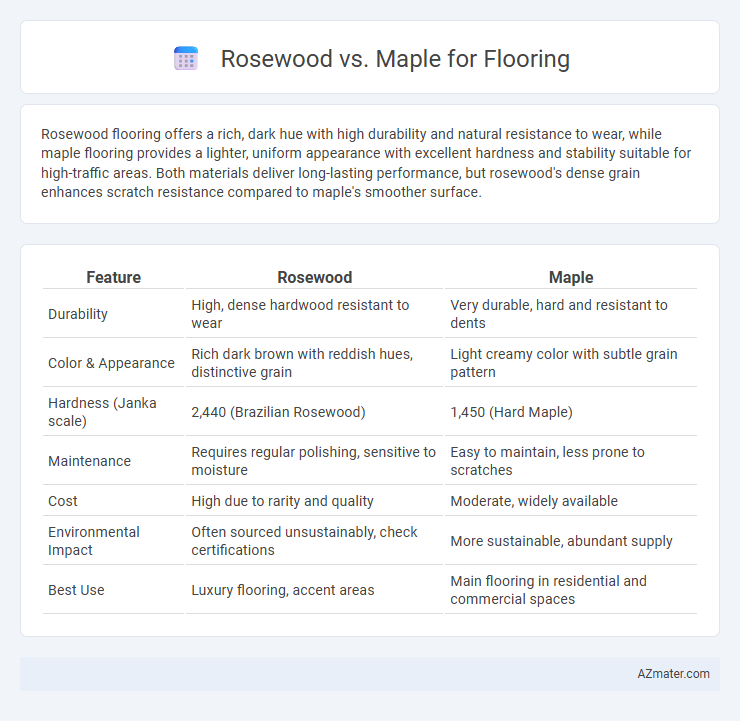Rosewood flooring offers a rich, dark hue with high durability and natural resistance to wear, while maple flooring provides a lighter, uniform appearance with excellent hardness and stability suitable for high-traffic areas. Both materials deliver long-lasting performance, but rosewood's dense grain enhances scratch resistance compared to maple's smoother surface.
Table of Comparison
| Feature | Rosewood | Maple |
|---|---|---|
| Durability | High, dense hardwood resistant to wear | Very durable, hard and resistant to dents |
| Color & Appearance | Rich dark brown with reddish hues, distinctive grain | Light creamy color with subtle grain pattern |
| Hardness (Janka scale) | 2,440 (Brazilian Rosewood) | 1,450 (Hard Maple) |
| Maintenance | Requires regular polishing, sensitive to moisture | Easy to maintain, less prone to scratches |
| Cost | High due to rarity and quality | Moderate, widely available |
| Environmental Impact | Often sourced unsustainably, check certifications | More sustainable, abundant supply |
| Best Use | Luxury flooring, accent areas | Main flooring in residential and commercial spaces |
Introduction to Rosewood and Maple Flooring
Rosewood flooring is prized for its rich reddish-brown hues and natural durability, making it a luxurious choice for high-traffic areas. Maple flooring offers a lighter, more uniform appearance with exceptional hardness and resistance to wear, ideal for both modern and traditional interiors. Both woods provide unique grain patterns and robust performance, catering to diverse aesthetic preferences and functional needs.
Key Characteristics of Rosewood Flooring
Rosewood flooring is prized for its rich, deep hues ranging from reddish-brown to dark brown with contrasting black streaks, offering a luxurious and exotic appearance. It is exceptionally durable and dense, making it resistant to dents and scratches, ideal for high-traffic areas. The wood's natural oils contribute to its resistance against moisture and pests, ensuring long-lasting performance with minimal maintenance.
Key Characteristics of Maple Flooring
Maple flooring is prized for its exceptional hardness and durability, making it ideal for high-traffic areas and households with pets or children. The wood features a fine, uniform grain with a light, creamy color that enhances brightness and offers a versatile backdrop for various interior styles. Its natural resistance to wear and ability to take stains evenly contribute to its popularity in both residential and commercial flooring applications.
Durability Comparison: Rosewood vs Maple
Rosewood offers exceptional durability with high hardness ratings around 2200 on the Janka scale, making it resistant to dents and scratches, ideal for high-traffic areas. Maple features a slightly lower Janka hardness of approximately 1450, providing good durability but less resistance to wear compared to rosewood. Both woods deliver solid flooring options, but rosewood's superior hardness ensures a longer-lasting surface in demanding environments.
Color and Grain Differences
Rosewood flooring features deep reddish-brown hues with intricate, swirling grain patterns that add warmth and a luxurious feel to a space. Maple flooring offers a lighter, creamy to pale golden color with a smooth, consistent grain that enhances brightness and creates a clean, modern look. The contrast in color intensity and grain complexity makes rosewood ideal for rich, dramatic interiors, while maple suits environments seeking subtle elegance and neutrality.
Cost Analysis: Rosewood vs Maple
Rosewood flooring typically commands a higher price due to its rarity, durability, and rich appearance, with costs ranging between $8 to $14 per square foot. Maple flooring is more budget-friendly, generally priced around $3 to $7 per square foot, offering a hard and resilient surface suitable for high-traffic areas. When considering installation and long-term maintenance, rosewood may incur additional expenses, while maple provides a cost-effective and durable flooring solution.
Maintenance Needs and Longevity
Rosewood flooring offers exceptional durability and a naturally dense grain that resists scratches and dents, requiring minimal maintenance beyond regular sweeping and occasional polishing. Maple floors, while durable, are softer than rosewood and more susceptible to dents and wear, demanding more frequent refinishing and protective measures to maintain their appearance. Both woods boast long lifespans when properly cared for, but rosewood's inherent hardness and resistance to moisture provide superior longevity in high-traffic or humid environments.
Environmental Impact and Sustainability
Rosewood flooring is often sourced from slow-growing tropical trees, leading to concerns about deforestation and habitat loss, making it less sustainable compared to maple. Maple, a fast-growing hardwood native to North America, is typically harvested from well-managed forests, reducing its environmental footprint and promoting sustainable forestry practices. Choosing maple flooring supports responsible resource use and a lower ecological impact, essential for eco-conscious flooring decisions.
Best Applications for Each Wood Type
Rosewood flooring excels in luxury spaces and high-traffic areas due to its exceptional hardness and rich, dark grain patterns that add warmth and elegance. Maple flooring suits residential settings and contemporary designs, offering a smooth, light-colored surface that enhances brightness and complements minimalist aesthetics. Each wood type delivers durability but Rosewood is better for formal or traditional interiors while Maple is ideal for casual or modern environments.
Final Verdict: Choosing Between Rosewood and Maple
Rosewood flooring offers exceptional durability, rich color variation, and a luxurious aesthetic, making it ideal for high-traffic areas and sophisticated interiors. Maple flooring provides a lighter, more uniform appearance with excellent hardness and resistance to wear, suited for modern, minimalist designs and spaces requiring bright, clean finishes. The final decision depends on the desired aesthetic and durability needs, with rosewood favored for bold, statement flooring and maple preferred for classic, versatile applications.

Infographic: Rosewood vs Maple for Flooring
 azmater.com
azmater.com